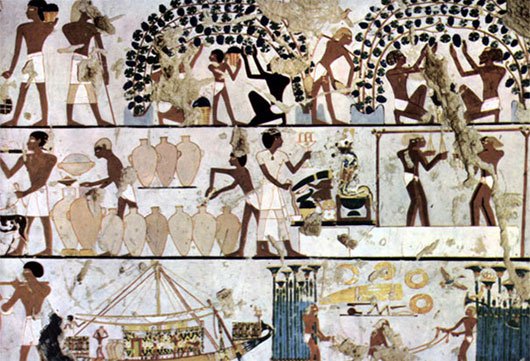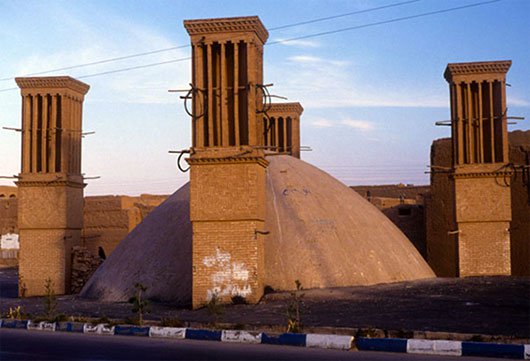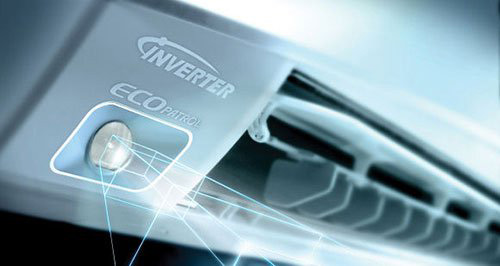How is air conditioning created?
During the hot summer days today, air conditioning is one of the indispensable products for many people. But surely not everyone knows when and how air conditioner is created. Let's find out through the article below.
The oldest cooling method
Not only modern people today but since ancient times people have sought to cool, adjust the temperature of houses on hot sunny days.

According to research by archaeologists and historians, the earliest model of air conditioner appeared from ancient Egypt. To cool indoor air and avoid the hot dryness of the desert climate, ancient Egyptians hung bundles of water-proof reed in the window. When the wind blows through the window, it brings steam into the house.

Ancient Romans cooled the house by installing plumbing around the wall. The medieval Persians built wind towers and cisterns on the roof to cool the indoor air in hot times.

Chinese people in the Han Dynasty invented a "fan" to cool the air powered by human power. This cooling system consists of 3 wheels with a diameter of 3 meters and must be rotated by hand to create airflow. Later, the Chinese also created a water-powered system to create a cool air-cooled air flow called Luong Thien. This system was installed in the palace in 747 by King Tang Xuanzong (712-762).
Cooling methods are improved by physical-chemical principles
By the 17th century, inventor Cornelis Drebble (1572-1633) introduced King James I of England with a model of air cooling by adding salt to water. This system is named "turning summer into winter".

In 1758, two chemists, Benjamin Franklin (1785-1788), governor of Pennysylvania, and John Hadley (1731-1764), professor at Cambridge University discovered the principle of evaporation. Franklin and Haldley have demonstrated that evaporation of volatile liquids such as alcohol or ether can reduce the temperature of an object below the freezing point of water.
After successfully using evaporation to lower the temperature of the mercury thermometer from 18 degrees C to -14 degrees C, Franklin concluded that 'freezing a man to die in the summer is a job absolute possible".

By 1820, Michael Faraday (1791-1867), a British chemist and inventor, had successfully experimented with compressing and liquefying ammonia gas to cool the surrounding air.
In 1842, Scottish physician John Gorrie (1803-1855) created ice by using air compressing techniques to cool patients in the hospital. After this success, John also hopes to create a giant ice making machine that can cool a building, even a city. But John's plan failed because his sponsor suddenly died.


By the 19th century, the model of mechanical ice making machine appeared soon. In 1851, an engineer named James Harrison successfully built a ice-making machine operated by a flywheel and commissioned it on the banks of the Barwon River at Rocky Point in the Geelong region, Australia.

Harrison's system works by using a compressor to push air through a condenser, the air flow is cooled and liquefied. After that, liquefied gas will move through the pipe system and return to the vapor to cool the air. This machine can produce 3000kg of ice water every day.

In 1902, Willis Carrier (1875-1950) invented an air conditioner model while working for mechanical company Buffalo Forge. Carrier model is designed to be used for a printing factory, which helps control the temperature and humidity of the air in the factory.

Carrier air-conditioning equipment works by pushing air through a cooled tube with liquefied ammonia. To control the humidity in the room at 55%, he designed his system of 2 main ducts, 1 for air cooling and 1 for supplying humid air.

With this invention, Carrier was named the father of the modern air conditioner model that we are using.

However, Carrier's air-conditioning system is very large, loud, extremely expensive and very dangerous due to the use of toxic chemicals called ammonia to cool the air.
In 1911, Carrier continued to introduce "cooling formulas with a reasonable moisture ratio", this cooling method is still applicable in some areas of the refrigeration industry.
In 1914, Carrier-built air conditioning systems were first installed for a home in Minneapolis. This machine is 2.1 meters high, 1.8 meters wide and nearly 7 meters long. But this machine has never been used because no one lives in the house. However, homeowners still have to spend more than $ 60,000 per year to maintain the entire house.

In 1917, the first air conditioner installed for a movie theater was the New Empire Cinema in Montgomery, Alabama. After that, other cinemas also quickly installed air conditioning systems and received enthusiastic response from customers.
In 1922, Carrier replaced ammonia toxic biochemicals with other safer compounds than dielene (dichlorethylene, or C2H2Cl2). At the same time, the air conditioner size is also minimized by Carrier and produces much more neat machines. 2 steps to improve this breakthrough of Carrier has helped air conditioners become more popular.
From 1924 to 1930, air conditioning began to appear in US government offices and many other important buildings throughout the United States. At this stage, substances including ammonia, methyl chloride or propane are used as a welding agent of air conditioners.

In 1928, American engineer Thomas Midgley, Jr. (1889-1944) successfully produced Freon as a biochemical in refrigeration technology. This is an inert gas, difficult to burn, non-toxic to humans. It was widely used for air-conditioner generations until 1994 later.
In 1931, the first compact sized air conditioner fits on the window sill and cooled the space of an existing room created by HH Schultz and JQ Sherman. Their prices are very expensive, from 10,000 to 50,000 dollars (equivalent to 120,000 to 600,000 USD currently).
Since then, air conditioners have been increasingly improved to be small, light, high-performance, environmentally friendly and cheaper. Air conditioners gradually become popular appliances in the US.
In 1957, German engineer Heinrich Krigar, successfully built the first centrifugal compressor in the world, marked the spectacular turning point of air conditioning technology.
In 1969, the cooling system was equipped with Neil Armstrong and Buzz Aldrin's astronaut suits against space conditions. These two astronauts wore them when they made a walk on the Moon.

Along with the development of science and technology, air conditioners continue to be improved using environmentally friendly and high-performance cooling methods. Most recently, inverter air-conditioner technology uses inverter technology to change compressor frequency to achieve the desired temperature with minimum thermal amplitude, saving electricity.
You should read it
- Learn the structure, installation and use of air conditioners
- Things to keep in mind when buying used air conditioners
- Portable air conditioners: How to buy the best one for your home
- Compare air conditioners
- Maintain conditioning and things you need to remember
- What types of air conditioner are available today?
- How to check when buying and assembling air conditioners
- Samsung Air Conditioning, Air Conditioning Code: How to check and diagnose
- 4 common problems in air conditioning in the summer
- Popular modes of use on air conditioners
- How to timer Panasonic air conditioner
- Standard for selecting copper pipes before installing air conditioners and air conditioners






 Maintain conditioning and things you need to remember
Maintain conditioning and things you need to remember Harmless effects are not expected when regular air conditioning is not maintained
Harmless effects are not expected when regular air conditioning is not maintained Hot 50 degrees C, Qatar installed huge outdoor air conditioning to help people feel cooler
Hot 50 degrees C, Qatar installed huge outdoor air conditioning to help people feel cooler Should I buy an air conditioner in summer?
Should I buy an air conditioner in summer? Air conditioning does not work, causes and remedies
Air conditioning does not work, causes and remedies 4 common problems in air conditioning in the summer
4 common problems in air conditioning in the summer